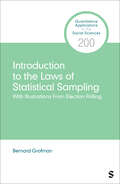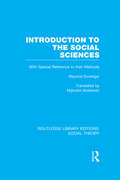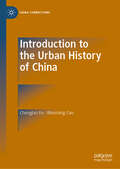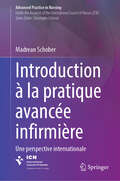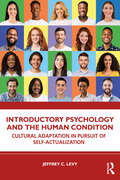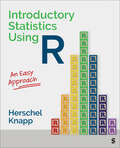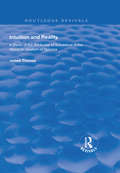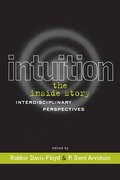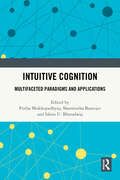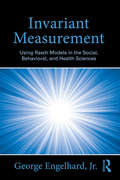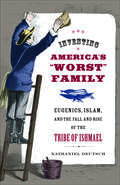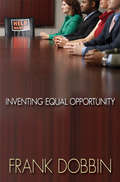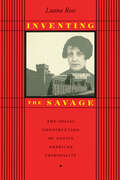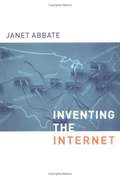- Table View
- List View
Introduction to the Laws of Statistical Sampling: With Illustrations From Election Polling (Quantitative Applications in the Social Sciences)
by Bernard GrofmanIntroduction to the Laws of Statistical Sampling is a clear, concept-driven guide for readers new to statistical sampling, including doctoral students and early-career researchers. Requiring only basic algebra and access to Excel, Bernard Grofman uses simulation and real-world examples—especially from election polling—to build intuition around the Central Limit Theorem and other foundational principles. Structured around six essential questions and ten "laws" of statistical sampling, the book walks readers step by step through reasoning and calculations, highlighting common pitfalls and counterintuitive results. With its accessible language, practical focus, and deep pedagogical insight, this monograph is both a primer for beginners and a valuable refresher for experienced analysts.
Introduction to the Laws of Statistical Sampling: With Illustrations From Election Polling (Quantitative Applications in the Social Sciences)
by Bernard GrofmanIntroduction to the Laws of Statistical Sampling is a clear, concept-driven guide for readers new to statistical sampling, including doctoral students and early-career researchers. Requiring only basic algebra and access to Excel, Bernard Grofman uses simulation and real-world examples—especially from election polling—to build intuition around the Central Limit Theorem and other foundational principles. Structured around six essential questions and ten "laws" of statistical sampling, the book walks readers step by step through reasoning and calculations, highlighting common pitfalls and counterintuitive results. With its accessible language, practical focus, and deep pedagogical insight, this monograph is both a primer for beginners and a valuable refresher for experienced analysts.
Introduction to the Science Popularization Industry
by Fujun Ren Yizhong Zhang Guangbin LiuThis book systematically introduces the popular science industry. It firstly summarizes the social basis and research status of the development of contemporary science popularization industry and also elaborates on the basic theory and main forms of science popularization industry. The most important feature of this book is its focus on the practice and case study of the development of science popularization industry in China. Meanwhile, it analyzes the development of science popularization industry in China from four perspectives: the basis and conditions, the current situation and countermeasures, the main promotion tasks, and the policy suggestions for promotion. The book analyzes the development trend of science popularization industry in China. It can be used as a reference book for science popularization practitioners and enthusiast to learn and understand the theory and practice of science popularization industry. It can also be used as a textbook for the cultivation and training of science popularization talents.
Introduction to the Social Sciences (Routledge Library Editions: Social Theory)
by Maurice DuvergerProfessor Duverger at last provides the student with an overall view of the methodology of the social sciences. He briefly traces the origin of the notion of a social science, showing how it emerged from social philosophy. Its essential elements and pre-conditions are described; the splintering of social science into specialist disciplines is explained, and the need for a general sociology confirmed. The techniques of observation used by social scientists are dealt with in some detail and the unity of the social sciences is illustrated by examples of the universal application of these techniques. Documentary evidence in its various forms are described along with the basic analytical techniques, including quantitative methods and content analysis. Other methods of gathering information through polls, interviews, attitude scales and participant observation are all described. Professor Duverger brings together the different kinds of analysis used to assess the information thus gathered. Arguing that observing and theorizing are not two different stages or levels of research, he examines the practical value and difficulties of general sociological theories, partial theories and models and working hypotheses. He both describes and assesses the limitations of experiment and the scope of comparative methods in the social sciences. He then gives elementary instructions for using and assessing the value of mathematical techniques. The possibilities of presenting social phenomena through graphs and charts are also explored. There are useful book lists and diagrams.
Introduction to the Urban History of China (China Connections)
by Chonglan Fu Wenming CaoThis book explores China’s urban development, examining the history and culture of Chinese cities and providing a cultural background to the rapid urban development of contemporary China. It offers a new perspective on Chinese urban history, showcasing the traditional culture which underpins the emergence of the modern city and highlighting how traditional Chinese philosophical thought is reflected in the culture of urban planning and architecture in China, notably examining such issues as ‘the integration of man and nature’, yin and yang, bagua, and the Wu Xing.
Introduction à la pratique avancée infirmière: Une perspective internationale (Advanced Practice in Nursing)
by Madrean SchoberPublié sous les auspices du Conseil international des infirmières (CII), cet ouvrage offre une vue d’ensemble de la pratique avancée infirmière qui connaît actuellement un grand essor. Il aborde les questions centrales relatives aux fonctions regroupées sous cette appellation et au développement de ce type d’exercice. Ces questions sont fondamentales pour définir et distinguer la nature de la pratique avancée. Les sujets abordés comprennent la définition de ce type d’exercice, ses caractéristiques, le champ d’exercice, la formation préparant à un exercice en pratique avancée, la réglementation et la contribution apportée par la recherche. Les obstacles et les facilitateurs de l’exercice en pratique avancée sont présentés, y compris les questions éthiques qui se posent dans le contexte de son développement. Ce livre examine les développements internationaux dans ce domaine, comme le reflètent les études de cas et les exemples spécifiques à chaque pays. Il constitue une ressource précieuse pour les infirmières en pratique avancée, les enseignants, les responsables d’encadrement des établissements de santé. Ce livre a été traduit de l’anglais à l’aide d’une intelligence artificielle. Une révision du contenu a ensuite été effectuée par un expert du domaine.
Introductory Psychology and the Human Condition: Cultural Adaptation in Pursuit of Self-Actualization
by Jeffrey C. LevyIntroductory Psychology and the Human Condition provides an engaging, cohesive, and practical treatment of traditional psychological principles and theories.The book uses Maslow’s human needs hierarchy and Bronfenbrenner’s ecological theory of development as organizational schemas for considering how cultures have evolved to address human needs. It relates major psychological processes, including biology, perception, motivation, learning, and cognition, to lifespan and personality development in nomadic hunter-gatherer and technologically enhanced cultures. Human history is described as a feedback loop in which inventions and technologies result in the need for individuals and cultures to adapt to changing environmental and social conditions. By applying interdisciplinary perspectives of the humanities, social and natural sciences, and helping professions to the human condition, it offers a meaningful lens through which to study and interpret core psychological concepts. Chapters are supported by self-understanding and self-control exercises that help students place their lives within a cultural and historical context and apply the principles of psychology to themselves.Offering an engaging overview of the essential elements of an introductory psychology course in an accessible and approachable style, Introductory Psychology and the Human Condition is core reading for introductory students and will appeal also to a general audience interested in psychology.
Introductory Statistics Using R: An Easy Approach
by Herschel KnappFinally, a textbook that makes it simple to teach and learn introductory statistics using the R software! Herschel Knapp′s Introductory Statistics Using R: An Easy Approach is a jargon-free guide to real-world statistics designed to concisely answer three important questions: Which statistic should I use? How do I run the analysis? How do I document the results? Practical examples presented throughout the text with exercises at the end of each chapter build proficiency through hands-on learning. The student website includes datasets, prepared R code for each statistic in the R Syntax Guide, and tutorial videos. As well as learning statistics, with this text students learn how to convert numeric results into clear, publishable documentation.
Introductory Statistics Using R: An Easy Approach
by Herschel KnappFinally, a textbook that makes it simple to teach and learn introductory statistics using the R software! Herschel Knapp′s Introductory Statistics Using R: An Easy Approach is a jargon-free guide to real-world statistics designed to concisely answer three important questions: Which statistic should I use? How do I run the analysis? How do I document the results? Practical examples presented throughout the text with exercises at the end of each chapter build proficiency through hands-on learning. The student website includes datasets, prepared R code for each statistic in the R Syntax Guide, and tutorial videos. As well as learning statistics, with this text students learn how to convert numeric results into clear, publishable documentation.
Introductory Statistics Using SPSS
by Herschel KnappThe updated Second Edition of Herschel Knapp’s friendly and practical introduction to statistics shows students how to properly select, process, and interpret statistics without heavy emphasis on theory, formula derivations, or abstract mathematical concepts. Each chapter is structured to answer questions that students most want answered: What statistical test should I use for this situation? How do I set up the data? How do I run the test? How do I interpret and document the results? Online tutorial videos, examples, screenshots, and intuitive illustrations help students "get the story" from their data as they learn by doing, completing practice exercises at the end of each chapter using prepared downloadable data sets.
Introductory Statistics Using SPSS
by Herschel KnappThe updated Second Edition of Herschel Knapp’s friendly and practical introduction to statistics shows students how to properly select, process, and interpret statistics without heavy emphasis on theory, formula derivations, or abstract mathematical concepts. Each chapter is structured to answer questions that students most want answered: What statistical test should I use for this situation? How do I set up the data? How do I run the test? How do I interpret and document the results? Online tutorial videos, examples, screenshots, and intuitive illustrations help students "get the story" from their data as they learn by doing, completing practice exercises at the end of each chapter using prepared downloadable data sets.
Intuition and Reality: A Study of the Attributes of Substance in the Absolute Idealism of Spinoza (Routledge Revivals)
by James ThomasPublished in 1999, this study focuses on the work of absolute idealist readers of Spinoza's metaphysics, such as John Clark Murray and Leslie Armour. The text is intended to establish a better absolute idealist interpretation of the identity of Spinoza's one substance (reality) with each of its diversity of "attributes". Consideration is given to the interpretations developed by these earlier commentators, who read the attributes as one metaphysical being diversely interpreted. The author finds this disadvantageous in understanding the "parallelism" of the attributes, or Spinoza's doctrine that the same order and connection of things is found in each. This problem can be solved with an alternative absolute idealist reading of the attributes as one order diversely intuited.
Intuition: Interdisciplinary Perspectives
by Robbie Davis-Floyd P. Sven ArvidsonScience could never have proceeded without the creativity of intuition--yet intuition is poorly understood and poorly studied. In Intuition: The Inside Story, scholars explore the nature of intuition and its practical place in the social and behavioral sciences and the arts. These contributors present the latest theoretical developments and research and provide every day examples of intuition from the lab and field. They discuss the nature and experience of intuition from the perspectives of anthropology, philosophy, physics, engineering, psychology, medicine and midwifery. Contributors include: Marcie Boucouvalas, Guy Burneko, Brenda J. Dunne, Jeremy Hayward, Charles Laughlin, Evelyn Monsay, Anne Pineault, Luci Roncalli and Joe Sheridan.
Intuitive Cognition: Multifaceted Paradigms and Applications
by Ishita U. Bharadwaj Pritha Mukhopadhyay Sharmistha BanerjeeThis book is an exhaustive and evidence-based introduction to the concepts of intuitive cognition. It focuses on the foundations of intuitive and other forms of cognition, how it allows the integration of new information with existing knowledge along with their applications in diverse fields like business, teaching, marketing and education. The book examines the co-existence of intuition with deliberate information processing and defines the applicability of intuitive cognition from a multidisciplinary approach. What role does intuition play in driving effort, sensory experience, choices or in taking risks? And how can a greater understanding of intuitive cognition help with decision-making, understanding customers or patients and understanding student needs? It explores the efficacy of the unconscious and other forms of cognition, across multiple domains, such as creative art, education, organization, business and finance, neuro-marketing, artificial intelligence and spirituality.This volume will be useful for scholars and researchers of psychology, neuroscience, cognitive psychology, cognitive sciences, education, organizational behaviour, management studies, philosophy, and literature.
Intuitive Expertise and Financial Decision-Making (Routledge Focus on Accounting and Auditing)
by Michael Grant Fredrik NilssonThis book provides insights into the hidden role of intuitive expertise in financial decision-making. The authors show and discuss how expertise combined with intuitive judgments positively affect decision-making outcomes. The book builds on the latest academic studies in this emergent field. In combination with the academic perspective, the authors provide a field study that they conducted in the context of mergers and acquisitions (M&As), a common and critical strategic investment for companies. The interviews were carried out with experts and decision-makers in large and successful international companies (i.e., M&A experts, CEOs, CFOs, and board members). The book provides a solid theoretical and empirically based grounding of the topic. In addition, it offers suggestions to practitioners on how they can develop and nurture intuitive expertise in strategic investment decision-making. The report of the field study provides examples and quotes from interviews to visualize findings, thus helping practitioners gain understanding and insights from the text. The authors also discuss the downsides of intuitive expertise, such as biases and flawed decision-making. For scholars, students, and professionals, the book offers a concise and up-to-date summary of an emergent stream of research, exploring how cognition and judgment affect financial decision-making.
Intuitive Interaction: Research and Application
by Alethea BlacklerThis book explores recent research in intuitive interaction worldwide by a range of leading academics and practitioners in the field. It builds on past work as it ventures into new areas, such as how users perceive intuitiveness of an interface, how people experience intuitive interaction subjectively, and how we can use such understanding to design more engaging experiences. The book addresses how intuitive interaction is understood in different academic disciplines and how it has been researched in various parts of the world over the last 18 years. It covers how intuitive interaction can be applied in different contexts, like large scale urban installations, the developing world, in older populations, and in various industry applications. <P><P>Features: <li>Presents varied approaches to intuitive interaction research and application <li>Illustrates how to understand and apply intuitive interaction to interfaces <li>Provides a mix of academic and industry perspectives <li>Explores a variety of contexts for application of intuitive interaction <li>Encompasses design, IT, business, and psychological approaches
Intuitiver Methodeneinsatz in Coaching-Prozessen: Grundlagen und Praxisbeispiele (essentials)
by Margot BöhmDieses essential bietet einen Überblick über Grundansätze und Modelle, die ein freies, intuitiv-vorgehendes Coachen ermöglichen. Es bringt Beispiele für strukturorientierte Verfahren, die situativ geöffnet werden und für offene, kreative Vorgehensweisen, die erst im Prozess entstehen. Unter Rückgriff auf Verfahren z. B. aus dem Neuro-Linguistisches Programmieren wie der Arbeit auf Zeitlinien oder der Aufstellungen im Raum werden Beispiele für junge und erfahrene Coaches nutzbar gemacht. Die Autorin erläutert, inwiefern Intuition im Coaching erklärbar ist und ,,funktioniert" und macht Mut, diese im Verbund mit Methodenkenntnis souverän einzusetzen.
Invariant Measurement: Using Rasch Models in the Social, Behavioral, and Health Sciences
by George Engelhard Jr.This introductory text describes the principles of invariant measurement, how invariant measurement can be achieved with Rasch models, and how to use invariant measurement to solve measurement problems in the social, behavioral, and health sciences. Rasch models are used throughout but a comparison of Rasch models to other item response theory (IRT) models is also provided. Written with students in mind, the manuscript was class tested to help maximize accessibility. Chapters open with an introduction and close with a summary and discussion. Numerous examples and exercises demonstrate the main issues addressed in each chapter. Key terms are defined when first introduced and in an end-of-text glossary. All of the book’s analyses were conducted with the Facets program. The data sets used in the book, sample syntax files for running the Facets program, Excel files for creating item and person response functions, links to related websites, and other material are available at www.GeorgeEngelhard.com. Highlights include: A strong philosophical and methodological approach to measurement in the human sciences Demonstrations of how measurement problems can be addressed using invariant measurement Practical illustrations of how to create and evaluate scales using invariant measurement A history of measurement based on test-score and scaling traditions Previously unpublished work in analyzing rating data, the detection and measurement of rater errors, and the evaluation of rater accuracy A review of estimation methods, model-data fit, indices used to evaluate the quality of rater-mediated assessments, rater error and bias, and rater accuracy. Intended as a supplementary text for graduate or advanced undergraduate courses on measurement or test theory, item response theory, scaling theory, psychometrics, advanced measurement techniques, research methods, or evaluation research taught in education, psychology, and the social and health sciences, the book also appeals to practitioners and researchers in these fields who develop or use scales and instruments. Only a basic mathematical level is required including a basic course in statistic.
Invariant Measurement: Using Rasch Models in the Social, Behavioral, and Health Sciences
by George Engelhard, Jr. Jue WangThis is the second edition of an introductory text that describes the principles of invariant measurement; how invariant measurement can be achieved using Rasch measurement theory; and how to use invariant measurement to solve a variety of measurement problems in the social, behavioral, and health sciences. Rasch models are used throughout the text, but brief comparisons of Rasch models to other item response theory (IRT) models are also provided.Written with students in mind, this new edition was class-tested to help maximize accessibility. Chapters open with an introduction and close with a discussion and summary. All chapters have been updated from the first edition, and a new chapter on explanatory Rasch models has been added. Features include numerous examples and exercises to demonstrate the main issues addressed in each chapter. Key terms are defined when first introduced and included in a helpful end-of-text glossary.This book also benefits from online materials which include the data sets used in the book, sample syntax files for running the Facets program, Excel files for creating item and person response functions, and links to related websites.This book will act as a supplementary text for graduate or advanced undergraduate courses on measurement or test theory, IRT, scaling theory, psychometrics, advanced measurement techniques, research methods, or evaluation research taught in education, psychology, and other social and health sciences. It will also appeal to practitioners and researchers in these fields who develop or use scales and instruments. Only a basic mathematical level is required, including a basic course in statistics, ensuring it is an accessible resource for students and researchers alike.
Inventing America's Worst Family: Eugenics, Islam, and the Fall and Rise of the Tribe of Ishmael
by Nathaniel DeutschThis book tells the stranger-than-fiction story of how a poor white family from Indiana was scapegoated into prominence as America's "worst" family by the eugenics movement in the early twentieth century, then "reinvented" in the 1970s as part of a vanguard of social rebellion. In what becomes a profoundly unsettling counter-history of the United States, Nathaniel Deutsch traces how the Ishmaels, whose patriarch fought in the Revolutionary War, were discovered in the slums of Indianapolis in the 1870s and became a symbol for all that was wrong with the urban poor. The Ishmaels, actually white Christians, were later celebrated in the 1970s as the founders of the country's first African American Muslim community. This bizarre and fascinating saga reveals how class, race, religion, and science have shaped the nation's history and myths.
Inventing Equal Opportunity
by Frank DobbinEqual opportunity in the workplace is thought to be the direct legacy of the civil rights and feminist movements and the landmark Civil Rights Act of 1964. Yet, as Frank Dobbin demonstrates, corporate personnel experts--not Congress or the courts--were the ones who determined what equal opportunity meant in practice, designing changes in how employers hire, promote, and fire workers, and ultimately defining what discrimination is, and is not, in the American imagination. Dobbin shows how Congress and the courts merely endorsed programs devised by corporate personnel. He traces how the first measures were adopted by military contractors worried that the Kennedy administration would cancel their contracts if they didn't take "affirmative action" to end discrimination. These measures built on existing personnel programs, many designed to prevent bias against unionists. Dobbin follows the changes in the law as personnel experts invented one wave after another of equal opportunity programs. He examines how corporate personnel formalized hiring and promotion practices in the 1970s to eradicate bias by managers; how in the 1980s they answered Ronald Reagan's threat to end affirmative action by recasting their efforts as diversity-management programs; and how the growing presence of women in the newly named human resources profession has contributed to a focus on sexual harassment and work/life issues. Inventing Equal Opportunity reveals how the personnel profession devised--and ultimately transformed--our understanding of discrimination.
Inventing Indigenous Knowledge: Archaeology, Rural Development and the Raised Field Rehabilitation Project in Bolivia (Indigenous Peoples and Politics)
by Lynn SwartleyThis volume provides a multi-sited and multivocalic investigation of the dynamic social, political and economic processes in the creation and implementation of an agricultural development project. The raised field rehabilitation project attempted to introduce a pre-Columbian agricultural method into the contemporary Lake Titicaca Basin.
Inventing The Savage: The Social Construction of Native American Criminality
by Luana RossIn this pathfinding study, Ross draws upon the life histories of imprisoned Native American women to demonstrate how race/ethnicity, gender, and class contribute to the criminalizing of various behaviors and subsequent incarceration rates. Drawing on the Native women's own words, she reveals the violence in their lives prior to incarceration, their respective responses to it, and how those responses affect their eventual criminalization and imprisonment. Comparisons with the experiences of white women in the same prison underline the significant role of race in determining women's experiences within the criminal justice system.
Inventing Value: The Social Construction of Monetary Worth
by Dave Elder-VassValue is central to the market sectors of the contemporary economy, yet the best-established theories of value fail to expose how it operates and how it is manipulated for profit. This book begins to reconstruct the theory of value. In one sense, it argues, value is a personal assessment of worth, but those assessments draw deeply on normative standards. The book examines those standards and how they are formed, transformed and supported by the construction of new social structures. The empirical evidence comes from contemporary financial examples: the mortgage-backed securities that caused the global crash of 2008, how venture capitalists secure outrageous valuations for so-called unicorn companies, and the rise of Bitcoin. The result is a theory that shows how value is invented by value entrepreneurs in pursuit of their interests and thus provides a new basis for criticising the role of value in the commodity economy and the finance sector.
Inventing the Internet
by Janet AbbateSince the late 1960s the Internet has grown from a single experimental network serving a dozen sites in the United States to a network of networks linking millions of computers worldwide. In Inventing the Internet, Janet Abbate recounts the key players and technologies that allowed the Internet to develop; but her main focus is always on the social and cultural factors that influenced the Internets design and use. The story she unfolds is an often twisting tale of collaboration and conflict among a remarkable variety of players, including government and military agencies, computer scientists in academia and industry, graduate students, telecommunications companies, standards organizations, and network users. The story starts with the early networking breakthroughs formulated in Cold War think tanks and realized in the Defense Department's creation of the ARPANET. It ends with the emergence of the Internet and its rapid and seemingly chaotic growth. Abbate looks at how academic and military influences and attitudes shaped both networks; how the usual lines between producer and user of a technology were crossed with interesting and unique results; and how later users invented their own very successful applications, such as electronic mail and the World Wide Web. She concludes that such applications continue the trend of decentralized, user-driven development that has characterized the Internet's entire history and that the key to the Internet's success has been a commitment to flexibility and diversity, both in technical design and in organizational culture.
